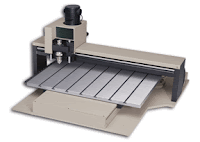The engraving industry started in 1603 with the introduction of pantograph milling machines. These machines were the only engraving equipment available until mid to late 1970’s. As computers started to become an aspect of everyday business in the early 80's rotary engravers compatible with computers began entering the scene. Due to the rotary engravers speedy processing time it wasn’t long before pantographs became a tool of the past.
The next upgrade in technology, quality, and speed capabilities is the laser engraving, laser cutting, and laser marking systems. Lasers are a no contact method that uses heat to mark, engrave, or cut through a variety of substrates. With advances in technology, lasers do not have the limitations of many rotary engravers. Here are some of the highlights to making the jump from a rotary engraver to a laser engraving system.
Laser Technology
What is a laser? Laser stands for Light Amplification by Stimulated Emission of Radiation, meaning an infrared monochromatic beam of light which uses heat to engrave, mark, or cut various materials. The CO2 and fiber lasers are the main types of lasers used in today’s industries. CO2 lasers are the highest powered continuous wave length laser currently available, their gas filled tube stimulates electrons into releasing energy that is channeled into a laser beam. On the other hand, a fiber laser is a coiled element such as ytterbium that already contains light and is stimulated to produce the laser beam.
Laser Technology
What is a laser? Laser stands for Light Amplification by Stimulated Emission of Radiation, meaning an infrared monochromatic beam of light which uses heat to engrave, mark, or cut various materials. The CO2 and fiber lasers are the main types of lasers used in today’s industries. CO2 lasers are the highest powered continuous wave length laser currently available, their gas filled tube stimulates electrons into releasing energy that is channeled into a laser beam. On the other hand, a fiber laser is a coiled element such as ytterbium that already contains light and is stimulated to produce the laser beam.
Fiber or CO2?
To decide on which type of laser you would need, it is best to see which materials can be processed with each laser.
To decide on which type of laser you would need, it is best to see which materials can be processed with each laser.
CO2 Lasers:
Fiber Lasers:
Performance
Lasers often outperform rotary engravers in speed, quality, and detail. One of the biggest advantages is the ability to engrave multiple items in one pass. This means if you have 6 items along the horizontal axis, each time the laser moves across the axis it will process all 6 items at once.
Ease of Use
To run the laser you will need a computer with a graphics software. I would recommend CorelDRAW, Adobe Illustrator, AutoCAD, or EngraveLab. Once you have your design developed, you simply print it to the laser (Trotec's JobControl Program) and choose your material from a list of settings.
By upgrading to a laser system you can quickly and easily expand your businesses capabilities due to the vast materials that can be processed with a laser. Due to their unlimited capabilities, low maintenance, and longest standard warranty a Trotec laser system offers a high return on investment (ROI) making it an extremely affordable choice.
Lasers often outperform rotary engravers in speed, quality, and detail. One of the biggest advantages is the ability to engrave multiple items in one pass. This means if you have 6 items along the horizontal axis, each time the laser moves across the axis it will process all 6 items at once.
Ease of Use
To run the laser you will need a computer with a graphics software. I would recommend CorelDRAW, Adobe Illustrator, AutoCAD, or EngraveLab. Once you have your design developed, you simply print it to the laser (Trotec's JobControl Program) and choose your material from a list of settings.
By upgrading to a laser system you can quickly and easily expand your businesses capabilities due to the vast materials that can be processed with a laser. Due to their unlimited capabilities, low maintenance, and longest standard warranty a Trotec laser system offers a high return on investment (ROI) making it an extremely affordable choice.
You may still want to keep your rotary engraver, as it can create a different look on certain materials. Having both a laser and a rotary engraver is an ideal situation, because with both machines you have an even wider array of possibilities.
Robin has been very pleased with her rayjet from the start. When asked how easy it was to learn the rayjet commander software Robin replied “The software was very easy to learn… It was really “Plug & Ray”!” She also shared the training DVD “Was a great hands on approach… making everything very easy to learn”.
Currently Robin has shifted almost all of her shop work from the rotary to the rayjet, leaving only one application to the rotary... Being that she loves that the rayjet is “cleaner, quieter, and faster”.
When asked if the rayjet laser was affordable compared to her rotary engraver Robin replied, “The initial cost was more for the laser; however, with the time saved I ended up saving more money as production costs were reduced and turnaround was quicker”.
Robin’s final words were, “Owning the rayjet has been a great experience, I only wish I had purchased the laser first”.
Find out More
If you're like Robin and are thinking about upgrading to a laser system please call Trotec at 866-226-8505 for more information... Or visit our website at www.troteclaser.com.







No comments:
Post a Comment